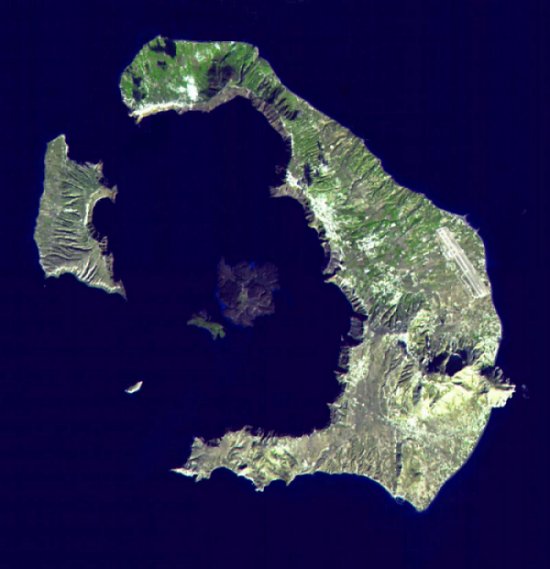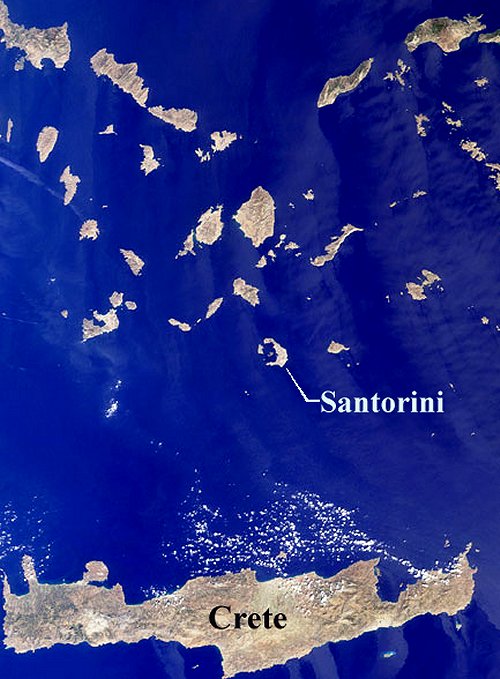The Thera Eruption
Today, a natural disaster alters history. The University of Houston's College of Engineering presents this series about the machines that make our civilization run, and the people whose ingenuity created them.
In 1988, engineers set out to duplicate Daedalus' flight, in a human-powered airplane called Daedalus. Daedlus was supposed to've flown from Crete to Sicily. That was too far, so the engineers compromised on a 74-mile flight, north to the islands of Santorini. Not a bad choice, considering that Santorini and Crete may've been linked historically back in the time of Daedalus' mythical flight.
Santorini was not always Santorini. Today, it's a small cluster of islands. The two larger ones sketch a six-mile circle in the sea, with three smaller islands in the middle. It's a blown-out volcano caldera. The remnants rise as much as a thousand feet on the sides with a 1300-foot depth in the center. Santorini is the remains of what was once a crescent-shaped island called Thera.
Three-and-a-half millennia ago, Thera exploded with earth-changing force. Its violence was much greater than the eruption of Krakatoa in 1883. And dust clouds from Krakatoa circled the earth.
Akrotiri, a city of 30,000 people on the seaward side of Thera, was buried intact under forty feet of ash and pumice. Excavations yield no human remains, and few personal belongings. The people on Thera saw disaster coming and they cleared out in time.
So how did this terrible event alter history? Our eyes naturally turn to Minoan civilization on Crete. The Minoans vanished not long after, and were replaced by Greek Mycenaeans. Some look to events in the Book of Exodus. The sun had to've been blotted out for days, and great tsunamis swept the Eastern Mediterranean.
But everything depends on when the eruption occurred. Egyptologists have dated it around 1500 BC. That matches art on Egyptian trade goods found in Akrotiri. It's also when we think the Hebrew exodus from Egypt took place. And it'd be consistent with Minoan civilization ending as a result of blast and tsunami damage.
But radio carbon dating demands much different scenarios. In a single issue of Science magazine, for example, we find two studies that place the eruption more than a century earlier. One very strong piece of evidence is an olive tree that was buried alive at Akrotiri. It provides very solid carbon dating.
So, it appears, Thera erupted far too soon to account for either the Exodus or the death of Minoan culture. The Minoans ended not with a bang but with a whimper. Yet, anything so large must've left tracks. One idea is that it drove deep-sea sailors from the nearby Islands back to the Greek mainland.
Greece had been a nation of coastal fishermen. The explosion of Thera may have brought new sailing technologies to her shores and made of her a seagoing nation. Instead of saving Moses, the explosion may well have given birth to Ulysses.
But even that's only an educated guess. The stark, sun-washed cliffs of Santorini continue to wait, with infinite patience, while we still struggle to unravel their long-kept secrets.
I'm John Lienhard, at the University of Houston, where we're interested in the way inventive minds work.
See three articles in the 28 April, 2006, Science, Vol. 312, Issue 5773. The first is an editorial description of the situation; the other two are technical articles: W. L. Friedrich, B, Fromer, M. Friedrich, J Heinemeier, T. Pfeiffer, S. Talamo, Santorini Eruption Radio Carbon Dated to 1627-1600 BC., pg. 548; S. W. Manning, C. B. Ramsey, W. Kutschera, T. Higham, B. Fromer, P. Steier, E. M. Wild, Chronology for he Aegean Late Bronze Age, 1700-1400 BC., pp. 565-569.
For a fine description of the Santorini/Thera site, see: W. L. Friedrich, Fire in the Sea: The Santorini Volcano: Natural History and the Legend of Atlantis.(tr. By Alexander R. McBirney) (Cambridge: Cambridge University Press, 2000).
I am most grateful for his counsel to Fr. Edward Bader, Professor of Archaeology at St. Thomas University, who has worked on Santorini.
Below, Satellite images of Santorini (top), and of Santorini, Crete, and other Greek islands (bottom)

